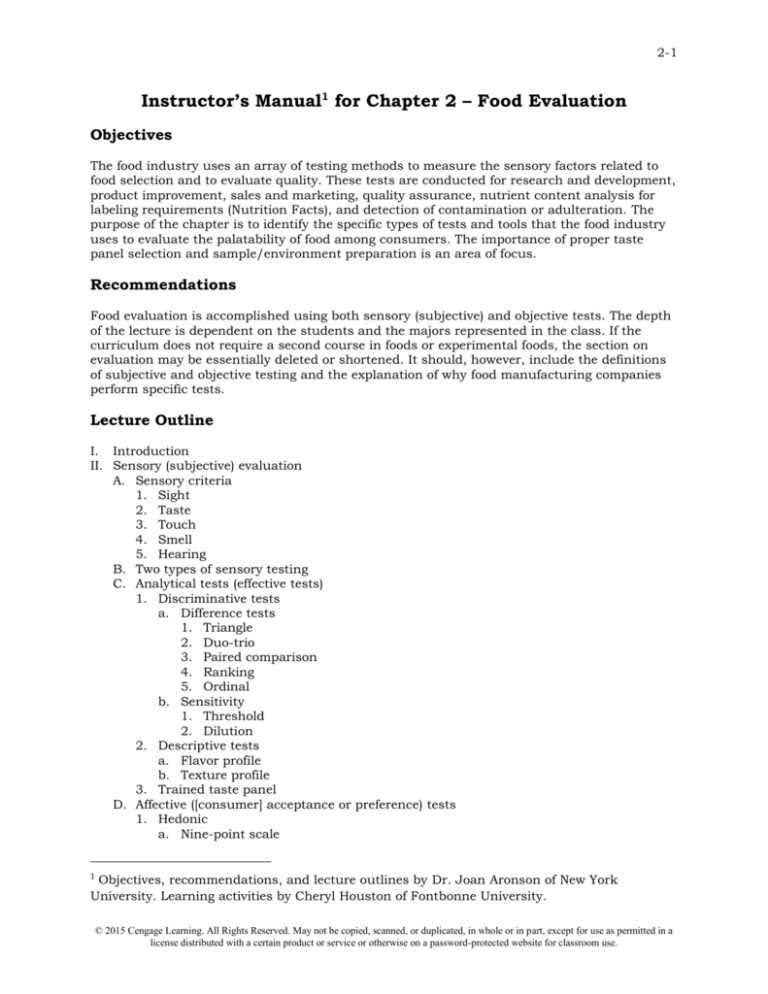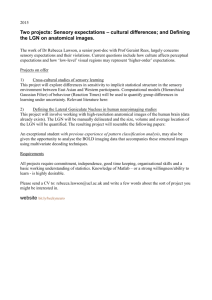
2-1
Instructor’s Manual1 for Chapter 2 – Food Evaluation
Objectives
The food industry uses an array of testing methods to measure the sensory factors related to
food selection and to evaluate quality. These tests are conducted for research and development,
product improvement, sales and marketing, quality assurance, nutrient content analysis for
labeling requirements (Nutrition Facts), and detection of contamination or adulteration. The
purpose of the chapter is to identify the specific types of tests and tools that the food industry
uses to evaluate the palatability of food among consumers. The importance of proper taste
panel selection and sample/environment preparation is an area of focus.
Recommendations
Food evaluation is accomplished using both sensory (subjective) and objective tests. The depth
of the lecture is dependent on the students and the majors represented in the class. If the
curriculum does not require a second course in foods or experimental foods, the section on
evaluation may be essentially deleted or shortened. It should, however, include the definitions
of subjective and objective testing and the explanation of why food manufacturing companies
perform specific tests.
Lecture Outline
I. Introduction
II. Sensory (subjective) evaluation
A. Sensory criteria
1. Sight
2. Taste
3. Touch
4. Smell
5. Hearing
B. Two types of sensory testing
C. Analytical tests (effective tests)
1. Discriminative tests
a. Difference tests
1. Triangle
2. Duo-trio
3. Paired comparison
4. Ranking
5. Ordinal
b. Sensitivity
1. Threshold
2. Dilution
2. Descriptive tests
a. Flavor profile
b. Texture profile
3. Trained taste panel
D. Affective ([consumer] acceptance or preference) tests
1. Hedonic
a. Nine-point scale
Objectives, recommendations, and lecture outlines by Dr. Joan Aronson of New York
University. Learning activities by Cheryl Houston of Fontbonne University.
1
© 2015 Cengage Learning. All Rights Reserved. May not be copied, scanned, or duplicated, in whole or in part, except for use as permitted in a
license distributed with a certain product or service or otherwise on a password-protected website for classroom use.
2-2
b. “Smily” or “frowny” faces for children
2. Personal preference
a. Paired preference
b. Ranking test
3. Untrained consumer taste panel
E. Taste panels
1. Skilled/trained or random
2. Characteristics of general taste panels
3. Representative consumer panel
F. Sample preparation
1. Environment for testing
2. Sampling procedure
III. Objective evaluation
A. Physical tests – measure size, shape, weight, volume, density, moisture, texture, and
viscosity
1. Visual evaluation
a. Microscope
b. Colorimeter
c. Spectrophotometer
2. Weight/volume measurements
3. Texture measurements
a. Penetrometer
b. Warner-Bratzler shear
c. Shortometer
4. Viscosity measurements
a. Line-spread test
b. Viscometer
5. Concentration measurements
a. Polarimeter
b. Atomic absorption
c. Moisture analyzer
B. Chemical tests
1. Examples
a. Benedict and Fehling tests – reducing sugars
b. Chromatography – flavor compounds
c. Electrophoresis – proteins
d. Enzyme tests – inactivity
e. Fuchsin test – aldehydes in fats and oils
f. Iodine value test – unsaturation in fats
g. Peroxide value test – fat oxidation
h. pH meter – acidity or alkalinity
i. Proximate analysis – macronutrient content
2. Testing in commercial laboratories
a. Microbial evaluation
1. Bacteria, yeast, and/ or molds
b. Nutrition Facts labels
c. Contamination and adulteration
d. Pesticides, herbicides, and industrial residues
e. Melamine
3. Chemical test examples conducted by a food testing company
a. Allergens, ammonia, ash
b. Calcium, calories (by calculation), calories from fat, carbohydrate (by
calculation), collagen, crude fiber
c. Fat (Soxhlet), fatty acid content (saturated, unsaturated, trans)
d. Iron
© 2015 Cengage Learning. All Rights Reserved. May not be copied, scanned, or duplicated, in whole or in part, except for use as permitted in a
license distributed with a certain product or service or otherwise on a password-protected website for classroom use.
2-3
e. Heavy metals, hydroxyproline
f. Moisture (water), maximum internal temperature, moisture/protein ratio
g. Nitrate, nutritional analysis and labeling
h. Oxidative rancidity
i. Percent bone, pesticide residue, pH, phosphate, protein
j. Salt, sodium nitrite, soy protein concentrate
k. Thiobarbituric acid reactive substances (TBA)
l. Unknown compound identification
4. Electronic noses (or e-nose) – Advantages and uses
C. Comparison of sensory and objective evaluations
1. Sensory testing is expensive & time consuming but essential
2. Objective testing is reliable & usually faster & cheaper
3. Both are necessary because they are complementary
Learning Activities
Activity 2-1: Subjective Tests for Food Evaluation
Chapter Reference: Food evaluation – subjective tests of difference
Materials Needed: Handout 2-1 (provided in this document)
Key Concepts:
Food evaluation
Subjective tests
Analytical tests
Difference tests
Instructions:
1. Place students in teams of 2-3 members.
2. Distribute the handout and review the directions.
3. Lead a large group discussion of the results.
Answer Key for Handout 2-2
Part A
1. Sensory (subjective) tests (pp. 23-25)
a. Analytical (effective) tests (pp. 24-25)
i. Discriminative tests (p. 24)
ii. Descriptive tests (p. 24)
b. Affective tests (pp. 24-25)
i.
ii.
2.
a.
b.
Hedonic tests (p. 24)
Personal preference (p. 24)
Objective tests (p. 26)
Physical tests (pp. 26-27)
Chemical tests (pp. 27-28)
Part B
1. Objective: physical test: viscosity test (pp. 26-27)
2. Sensory: discriminative test: difference test (pp. 24-25)
3. Objective: chemical test: analysis (pp. 27-28)
4. Sensory: affective test: personal preference (pp. 24-25)
5. Sensory: affective test: hedonic test (pp. 23-25)
6. Sensory: descriptive test: flavor profile (pp. 23-25)
7. Objective: physical test: density test (pp. 26-27)
© 2015 Cengage Learning. All Rights Reserved. May not be copied, scanned, or duplicated, in whole or in part, except for use as permitted in a
license distributed with a certain product or service or otherwise on a password-protected website for classroom use.
2-4
Handout 2-1
Team Name: _______________________________________________________________________
Directions: A food manufacturer asked you to design three experiments (paired
comparison, triangle test, duo-trio test) to see if consumers can detect the difference
between regular Ruffles® potato chips (control) and reduced-fat Ruffles® potato chips.
Illustrate your three experiments using the three templates below; be sure to label the
circles as appropriate.
Experiment #1: _______________________________________________ (name of test)
Experiment #2: _______________________________________________ (name of test)
Experiment #3: _______________________________________________ (name of test)
© 2015 Cengage Learning. All Rights Reserved. May not be copied, scanned, or duplicated, in whole or in part, except for use as permitted in a
license distributed with a certain product or service or otherwise on a password-protected website for classroom use.
2-5
Handout 2-2: Chapter 2 Student Review Worksheet
Part A: Outline the major types of food evaluation methods.
Major Test Types
Subcategories
1.________________________ =
a.________________________ =
or
i.___________________________
or
ii.___________________________
b._________________________ =
i.___________________________
or
ii.___________________________
2._________________________ =
a.________________________
or
b._________________________
Part B: Imagine you are responsible for planning some evaluation tests for Super Tasty brand
marinara (tomato) sauce. Name the type of test that is most appropriate for each question you
need to answer.
1. How easily will Super Tasty pour out of the jar and over a plate of pasta?
2. Can a trained taster tell the difference between Super Tasty sauce and another brand?
3. How much dietary fiber and fat are provided by 1 cup of Super Tasty sauce?
4. Out of 100 consumers, how many would prefer Super Tasty sauce over another brand?
5. What aspects (e.g., odor, color, texture) of Super Tasty Sauce do consumers like best, and
which do they like least?
6. What specific herbs and spices used in Super Tasty sauce can be detected by a trained
taster?
7. What is the mass per each ounce of Super Tasty sauce?
© 2015 Cengage Learning. All Rights Reserved. May not be copied, scanned, or duplicated, in whole or in part, except for use as permitted in a
license distributed with a certain product or service or otherwise on a password-protected website for classroom use.









